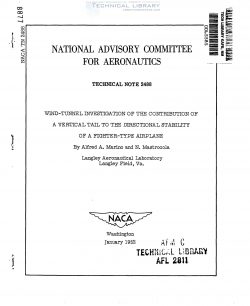naca-tn-2488
- Version
- 44 Downloads
- 1.42 MB File Size
- 1 File Count
- January 9, 2017 Create Date
- January 9, 2017 Last Updated
National Advisory Committee for Aeronautics, Technical Notes - Wind Tunnel Investigation of the Contribution of a Vertical Tail to the Directional Stability of a Fighter Type Airplane

Tests of a % -scale model of a typical fighter-type airplane were
made to investigate the contribution of a centrally located vertical
tail to the directional stability. Propeller—removed tests were made
with the stabilizer located in three vertical positions on the fuselage.
The separate contributions of the tail and the fuselage were determined
by means of pressure measurements on the tail and on the fuselage in
the vicinity of the tail.
The results of the tests indicated that the stabilizer, apart from
its favorable end—plate effect, had a large detrimental effect on the
contribution of the vertical tail surface to the directional stability.
This detrimental effect was greatest with the stabilizer high on the
fuselage and increased with increasing angle of attack. The contribution
of the fuselage at small angles of attack was supplied mainly by that
part above the stabilizer. The importance of the contribution of this
part of the fuselage increased considerably as the stabilizer was moved
down. The contribution of the fuselage below the stabilizer was.negligible
at small angles Of attack; at high angles of attack the contribution of
the fuselage became appreciable when the depth of the fuselage below
the stabilizer was large.
A comparison of the test results with'results predicted by two
different design methods based on the concept of an effective tail area_
indicates that such methods cannot accurately predict the contribution
of a vertical tail to the directional stability for all airplane configu-
rations and flight conditions. It appears that, for airplanes with tail
configurations similar to the type investigated, a more satisfactory
method can be obtained by treating separately the contributions of the
vertical tail surface, the fuselage area ab_ove the stabilizer, and the-- H
fuselage area below the stabilizer.
Two widely accepted available methods -for predicting the contribution
of a vertical tail to the directional stability (references 1 and 2)
involve tail—area definitionscthat- include part of the lateral area of
the fuselage. The two tail—area definitions, however, are not—the same,
and the two methods do not give_consistent results.
| File | Action |
|---|---|
| naca-tn-2488 Wind Tunnel Investigation of the Contribution of a Vertical Tail to the Directional Stability of a.pdf | Download |
Comment On This Post